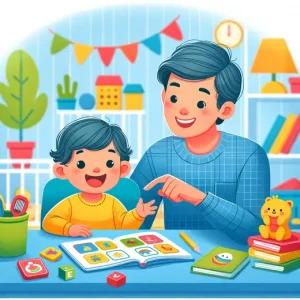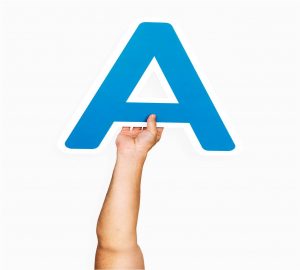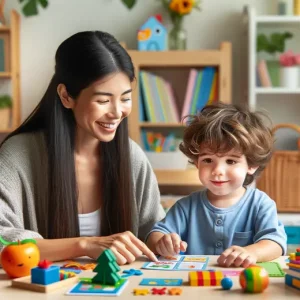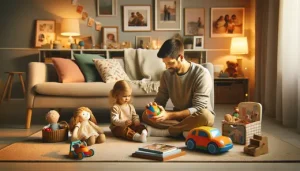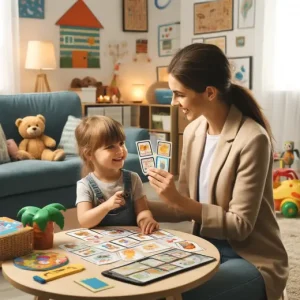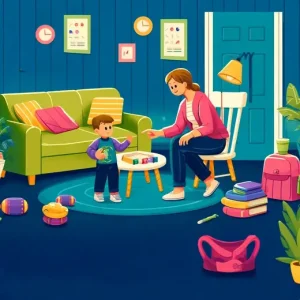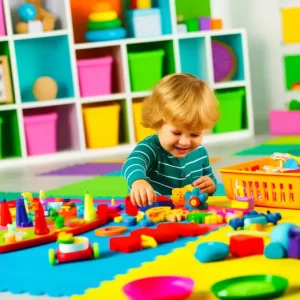Home Based Speech Therapy Activities for 2-3 Years Kids
By Rajini D
Last Updated: May 9, 2024
Early speech and language development are crucial for a child’s overall growth, impacting their communication skills and social interactions. Home-based speech therapy activities can be highly beneficial, offering a flexible, cost-effective way to support these developmental milestones right in the comfort of your home. Engaging in such activities helps strengthen your child’s language abilities and enhances the emotional bond between you and your child. Parents are encouraged to actively participate in these simple yet effective exercises to see noticeable improvements in their toddler’s communication skills.
5 Home Based Speech Therapy Activities for 2-3-Year-Olds
Pronoun Adventure

Pronoun Adventure is a fantastic activity to help your toddler understand and use pronouns like ‘he,’ ‘she,’ and ‘they‘ correctly, which are fundamental components of speech. To conduct this activity at home, use puppets or dolls to represent different characters and create simple scenarios where pronouns are used frequently. For example, “She is jumping,” “He is running,” and “They are playing.” Narrate actions using pronouns and encourage your child to repeat or create their sentences. Keep the sessions lively by changing scenarios and introducing new toys to maintain their interest.
Adjective Adventure
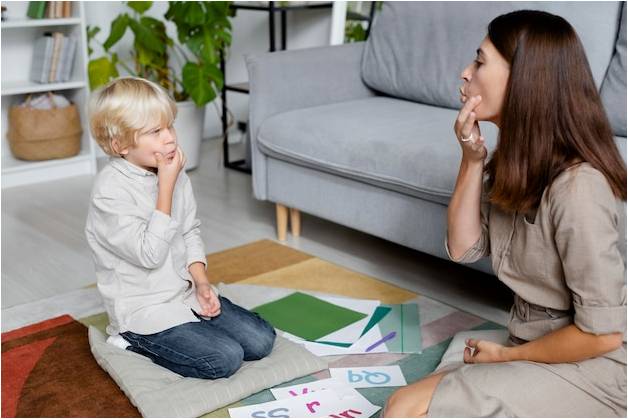
Adjectives spice up language by describing nouns, making speech more detailed and colorful. Adjective Adventure involves integrating adjectives into everyday play. Start with simple adjectives like big, small, hot, cold, soft, and hard. While playing with your child, use these adjectives to describe objects around you. For instance, “The big ball is under the small table,” or “The soft pillow is on the hard chair.” This not only helps in vocabulary building but also enhances sensory awareness.
Preposition Playtime
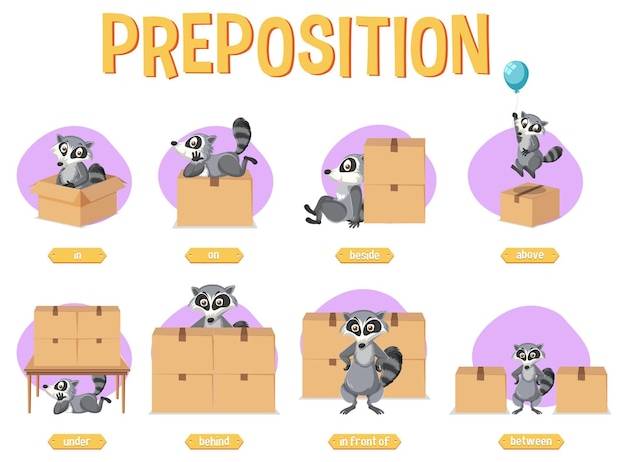
Prepositions are key building blocks in sentence structure. Preposition Playtime can be as simple as a hide-and-seek game where you hide a toy and guide your child to find it using prepositions: “Is it under the pillow? Is it behind the curtain?” It’s a playful way to teach words like in, on, under, beside, and between, which are crucial for understanding spatial relationships.
Understanding of Possessive Forms
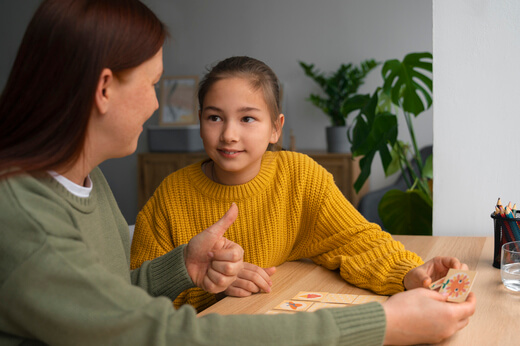
Understanding possessive forms like my, your, and ours helps toddlers express ownership and relationships. Through the “My, Your, Our World” activity, you can use items around the house to teach possessive pronouns. For example, while eating, you might say, “This is my spoon, that is your spoon.” Extend this by using toys, books, and clothes to reinforce the concept. Playing sharing games can also help explain the difference between my, your, and ours, promoting language skills and social bonding.
Quantifier Quest
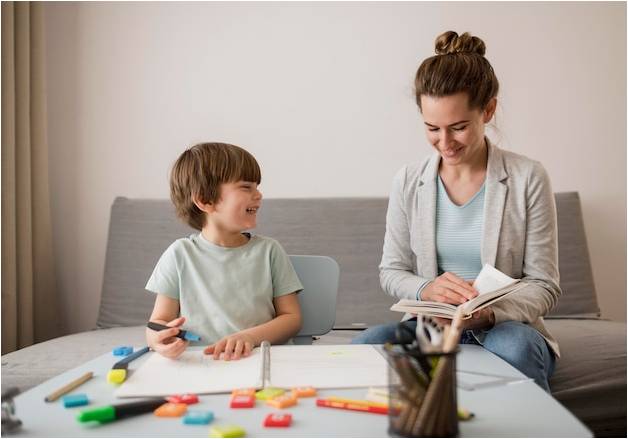
Quantifiers such as many, few, all, and some are essential for describing quantities. Quantifier Quest can include activities like snack time, where you ask, “Do you want some grapes?” or “Can you give me many cookies?” Use everyday opportunities to introduce these concepts, such as during playtime with blocks or sorting different colored balls, to teach counting and quantity
Speech Development Milestones for 2-3 Years Olds
Overview of Typical Speech and Language Milestones at This Age
Between the ages of 2 and 3, children undergo significant advancements in their speech and language skills. These developments are critical, forming the foundation for more complex communication abilities later in life.
Vocabulary Development:
By age 2, most children have a vocabulary of about 50 to 100 words. As they approach 3 years, their vocabulary rapidly expands, and it is not uncommon for a 3-year-old to have between 200 to 1,000 words. This wide range reflects individual differences influenced by environmental exposure and parental interaction.
Sentence Formation:
During this period, children start combining words into more complex structures. Initially, they may begin with simple two-word phrases like “more juice” or “mommy go.” As their vocabulary expands, they progress to three- to four-word sentences, and their ability to express a broader range of ideas and requests improves.
Understanding and Commands:
Children between 2 and 3 should be able to follow simple commands without visual cues and understand more complex directives with context. They also start recognizing the names of familiar objects, people, and body parts, demonstrating an increasing comprehension of the world around them.
Speech Intelligibility:
At 2 years old, a child’s speech is typically about 50% understandable to a stranger. By age 3, their speech clarity should improve to about 75% intelligibility. This increase reflects their growing mastery of speech sounds and the ability to form words accurately.
Engagement in Conversations:
Children in this age group begin actively engaging in simple conversations using their expanding vocabulary. They can answer simple questions, ask for things they want, and even use their words to express feelings.
Activities to Encourage Development:
- Interactive Reading: Choose picture books with simple plots and encourage your child to point to and name objects and actions.
- Play-Based Learning: Use toys to create scenarios that encourage your child to form sentences, such as playing with a toy kitchen or a dollhouse.
- Song and Repetition: Songs and nursery rhymes with simple, repetitive language can enhance vocabulary and speech sound mastery.
Monitoring and Support:
Parents are encouraged to monitor their child’s speech and language development and consult a speech-language pathologist if there are concerns about delays or abnormalities. Early identification and intervention can critically support a child’s communication skills.
Signs of Normal Development vs. Potential Delays
Typical Speech Development Milestones in Toddlers
- Using Gestures: Toddlers often use gestures to communicate before they can speak. Gestures such as pointing, waving, and nodding are positive signs of communication intent.
- Making Sounds: Attempting to vocalize to gain attention or express needs is a crucial early step in speech development.
- Understanding Basic Requests: Showing comprehension of simple commands or requests, like “Come here” or “Look at this,” indicates that the toddler is processing and understanding language.
Signs of Concern in Speech Development
- Limited Vocabulary: By a certain age, toddlers should start forming a basic vocabulary. A very limited set of words or an absence of simple word combinations might be a sign of delayed speech development.
- Disinterest in Interaction: A lack of interest in interactive gestures or verbal communication can indicate potential challenges in speech and social development.
- Non-responsive to Social Cues: Difficulty responding to their name or following simple instructions might suggest hearing issues or developmental delays.
When to Consider Professional Advice
While variations in development are normal, consistently missing multiple milestones might warrant professional evaluation. If you notice your child is significantly behind in language skills compared to their peers, or if you see regression in their communication abilities, it’s advisable to consult a pediatrician or speech-language pathologist. Early intervention can be key in helping address any underlying issues and setting your child on the path to effective communication.
Fun and More Effective Home Based Speech Therapy Activities for 2-3 Year Old Kids
| Activity | Description |
|---|---|
| Plural Playtime | Use favorite books and stories to practice story retelling to enhance memory and language skills. |
| Negation Exploration | Use simple games to teach negation, saying things like “We do not run indoors” to help them understand the concept of not. |
| Emotion Expression Adventure | Help your child express different emotions by mimicking facial expressions and describing feelings. |
| Phrase Formation Fun | Encourage your child to build longer phrases during play by narrating their actions in complete sentences. |
| Question Discovery | Foster curiosity by asking open-ended questions and encouraging your child to ask questions during storytelling. |
| Colors and Shapes Exploration | Engage in games that involve identifying different colors and shapes to enhance visual and verbal skills. |
| Concepts Adventure | Introduce concepts such as big/small and fast/slow during playful activities to broaden understanding. |
| Turn-Taking Playtime | Play games that require turn-taking to teach patience and social interaction. |
| Story-time Echoes | Practice story retelling to enhance memory and language skills, using favorite books and stories. |
| Function Fun | Discuss the uses of everyday objects to expand vocabulary and understanding of the world around them. |
| Animal Sound Safari | Create a playful learning environment by mimicking animal sounds and naming animals. |
| Alphabet Sound Play | Integrate phonics by focusing on the sounds that each letter of the alphabet makes through songs and games. |
| Sort and Learn | Teach sorting by color, size, or type to develop cognitive skills. |
| Melody Makers | Use music to teach rhythm and intonation patterns found in language. |
Benefits of Home-Based Speech Therapy Activities for 2-3-Year-Olds
Cost-effectiveness and Convenience
Home-based speech therapy offers a practical alternative to traditional clinical appointments, eliminating the need for travel and reducing associated costs such as transportation and time off work. This form of therapy allows for flexible scheduling around your family’s daily life, making it more affordable and accessible. Parents can conduct these activities in a familiar environment where the child feels comfortable and secure, enhancing the exercises’ effectiveness.
Strengthening the Parent-Child Bond through Activities
Engaging in speech therapy activities at home provides a unique opportunity for parents to bond with their children. These interactive sessions increase one-on-one time, build trust, and foster a deeper emotional connection between parent and child. The direct involvement in the child’s developmental progress also offers parents a rewarding sense of achievement and active participation in their child’s successes.
Customizable Activities that Fit into Daily Routines
Home-based speech therapy can be tailored to each child’s individual needs, incorporating their interests and the resources available at home. Activities can be designed to seamlessly integrate into daily routines, such as meal times, playtimes, or bedtime reading sessions. This integration helps create a natural learning environment where speech and language development can flourish without making it feel like a structured session. This customization keeps the child engaged and reinforces learning throughout the day in various settings and situations.
Strategies for Home-Based Speech Therapy Activities with 2-3 Year-Olds:
- Adapt to their physicality: At this age, children are not able to sit still for long. Speech therapy often involves interactive play on the floor, where therapists engage children with various toys. This approach might seem informal, but it is strategically designed to match their developmental stage.
- Focus on communication intent: The goal is to encourage children to initiate communication, whether through sounds, gestures, or eye contact. The interaction itself is more important than the mode of communication.
- Establish routines: Routines help children understand the world and develop language skills. Repeating activities like playing with toys can enhance their learning and make communication a natural part of their daily routine.
- Guide parents: Parents are advised to follow their child’s lead to understand their needs and expressions better. This understanding helps in teaching appropriate language use.
- Auditory bombardment: This technique emphasizes specific sounds to help children differentiate and learn them. For example, repeatedly pronouncing a difficult sound can increase phonological awareness.
- Delay formal speech goals: It’s often recommended that children wait until they are slightly older (around three years) for more structured speech sound training. Younger children benefit more from informal, play-based learning.
- Use communication temptation: Tempt children to communicate by showing them something they want, like a toy or phone, and then encouraging them to make a gesture or sound to express their desire.
- Teach through routines: Engage children in simple, fun routines that they can easily repeat, such as rolling a ball or pushing a car. These activities should be enjoyable and rewarding to encourage regular practice.
- Encourage appropriate play: Observing a child’s play can provide insights into their skills and preferences. Joining in their play and gradually introducing new ways to use toys can enhance their play and language skills.
Setting Up for Success
Creating a Conducive Learning Environment at Home
Establishing a positive and effective learning environment is essential for home-based speech therapy. Choose a quiet, well-lit space where distractions are minimized. This area should be comfortable and inviting, with familiar items that facilitate learning and interaction, such as books, toys, and art supplies. The space should encourage your child to focus and participate actively in therapy activities. Tailor the environment to be visually stimulating without being overwhelming, using elements that appeal to your child’s senses.
Consistency and Routine: The Keys to Success
Consistency in conducting speech therapy activities is crucial for your child’s progress. Set a regular schedule for therapy sessions to create a routine that your child can anticipate and prepare for. This regularity helps to establish a rhythm and sets clear expectations, making it easier for your child to engage in activities. Routine enhances learning and reinforces the skills being developed, promoting better retention and application of new language skills.
Safety Considerations During Activities
Safety is paramount when conducting any activities at home, especially for young children. Ensure that all materials used are safe and age-appropriate, free from small parts that could pose choking hazards. Keep the environment free from potential dangers like sharp edges, uncovered electrical outlets, or unstable furniture. Always supervise your child closely during activities to address any risks quickly and to provide support as needed.
Incorporating Technology in Home-Based Speech Therapy Activities for 2-3-Year-Olds
Incorporating technology into speech therapy can enhance learning through interactive and engaging tools. One highly recommended app for young children is “Speech Basics,” designed to support toddlers’ speech development. This app features age-appropriate activities focusing on pronunciation, vocabulary building, and sentence formation, all delivered in a fun, game-like environment that captures children’s interest and motivates them to participate.
Read More: Revolutionize Speech Therapy with Wellness Hub’s Tele Basics
Balancing Screen Time with Interactive Play
While technology can be a valuable tool in speech therapy, it is important to maintain a healthy balance with screen-free activities. Limit screen time according to pediatric guidelines—generally, no more than one hour per day for children aged 2-5. Use technology to complement a range of other activities that promote language development, such as reading books, singing songs, and engaging in face-to-face communication. This approach ensures that children benefit from diverse learning stimuli and interactions, which are crucial for their development.
Tips for Using Technology Effectively and Safely
To maximize the benefits of technology in speech therapy, follow these tips:
- Choose apps wisely: Select educational, user-friendly, and specifically tailored to speech development.
- Engage together: Use apps interactively with your child to guide their learning and discuss the presented content. This also turns screen time into an interactive bonding experience.
- Set up a safe digital environment: Use parental controls to manage what content your child can access and to monitor their usage time. Ensure the physical setup is safe, with devices placed at eye level to avoid strain and using child-friendly protective cases.
- Focus on quality over quantity: Opt for shorter, high-quality sessions using technology rather than prolonged periods of passive screen exposure. Make each session purposeful and aligned with your therapy goals.
Monitoring Progress and Adjusting Activities for 2-3-Year-Olds
How to Assess Your Child’s Speech Development Progress
Monitoring your child’s speech development is key to understanding the effectiveness of home-based therapy activities and determining the next steps. Regularly observe and note changes in your child’s ability to understand and use language. Key indicators include increased vocabulary, improved pronunciation, and the ability to form more complex sentences. Use simple checklists or progress charts aligning with their age group’s speech milestones to track these developments systematically. Additionally, recording sessions occasionally can provide a retrospective view of progress and areas that still need attention.
When to Adjust Activities to Better Suit Your Child’s Growing Skills
As your child masters specific skills, it’s important to introduce new challenges that can help advance their development. This could mean incorporating more complex vocabulary into games and activities or moving from simple sentences to more complex storytelling tasks. Pay attention to your child’s readiness cues, such as showing boredom with simpler tasks or expressing interest in new words or phrases, as these can guide you in making timely adjustments to the activities.
Keeping Track of Improvements and When to Seek Further Professional Help
Keep a detailed log of the activities performed and the skills practiced, along with notes on how your child responded to each session. This log can be invaluable for tracking long-term progress and identifying patterns that might necessitate changes in approach. If you notice plateaus in progress or regression, or if your child consistently struggles with certain aspects of speech that peers have mastered, it might be time to consult a speech-language pathologist. A professional can offer a detailed assessment and recommend interventions beyond the scope of home therapy.
Conclusion
Understanding the importance of early speech development is crucial, and as a parent, your involvement plays a pivotal role. Regularly engaging in home-based speech therapy activities supports your child’s communication skills and strengthens your bond. Remember, patience and persistence are key. Progress may be gradual, and every child develops at their own pace.
Here are some quick tips for integrating speech therapy activities into daily routines:
- Use meal times to practice new words and describe the day.
- Incorporate storytime at bedtime to enhance vocabulary and comprehension.
- Turn everyday outings into interactive language-learning opportunities.
Stay committed and use these everyday moments to encourage your child’s speech and language growth naturally. Your dedication will pave the way for their communication success.
Frequently Asked Questions
1. What are the best speech therapy activities for a 2-year-old at home?
Simple activities like singing nursery rhymes, reading picture books, and using toys to stimulate language through play are highly effective for 2-year-olds.
2. How can I encourage my 3-year-old to speak more clearly?
Encourage your child to tell stories about their day or describe what they’re doing while playing. Correct gently and model clear pronunciation.
3. Are there specific toys that help with speech development?
Yes, toys that encourage pretend play, such as dolls, action figures, and toy phones, can help enhance verbal expression and vocabulary.
4. How often should I engage my child in these speech activities?
Daily interaction is ideal. Aim for short, frequent sessions (about 5-10 minutes each) to keep your child engaged without overwhelming them.
5. What are some effective language games for toddlers?
Games like “I Spy” for object identification and simple board games that require taking turns can foster language skills and social interaction.
6. How can I use technology to aid speech therapy at home?
Use educational apps designed for speech development. These can include storytelling apps or interactive games that focus on word pronunciation and sentence formation.
7. What should I do if my child is not interested in speech activities?
Keep activities fun and varied. Follow your child’s interests, whether it’s dinosaurs or space, and incorporate these themes into your speech therapy activities.
8. Can everyday activities be turned into speech therapy exercises?
Absolutely. Narrate everyday activities like cooking or grocery shopping to build vocabulary. Ask your child questions and encourage them to describe their actions or surroundings.
9. How can I help my child expand their vocabulary?
Introduce new words during play and daily activities. For example, if playing with a farm set, teach words like “tractor,” “barn,” “cow,” etc. Repeat new words often and in different contexts.
10. What signs should I look for that indicate my child might need professional speech therapy?
If your child is using fewer words than peers, has difficulty pronouncing most sounds, struggles to put words into sentences, or shows frustration when trying to communicate, consider consulting a speech therapist.
About the Author:
Rajini Darugupally
M.Sc., Speech-Language Pathologist (9+ years of experience)
Rajini is a passionate and dedicated Speech-Language Pathologist with over 9+ years of experience specializing in children’s developmental speech and language disorders and rehabilitation in adults. Driven by a desire to empower each individual to find their voice, Rajini brings a wealth of experience and a warm, genuine approach to therapy.
At Wellness Hub, she thrives in a team environment that values innovation, compassion, and achieving results for their clients.
Connect with Rajini to learn more about how she can help you or your loved one find their voice.
Book your Free Consultation Today
Parent/Caregiver Info:
Client’s Details:
* Error Message
